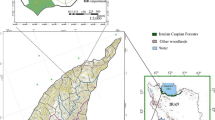Abstract
This paper presents equations for estimating limiting stand density for T. undulata plantations grown in hot desert areas of Rajasthan State in India. Five different stand level basal area projection models, belonging to the path invariant algebraic difference form of a non-linear growth function, were also tested and compared. These models can be used to predict future basal area as a function of stand variables like dominant height and stem number per hectare and are necessary for reviewing different silvicultural treatment options. Data from 22 sample plots were used for modelling. An all possible growth intervals data structure was used. Both, qualitative and quantitative criteria were used to compare alternative models. The Akaike’s information criteria difference statistic was used to analyze the predictive ability of the models. Results show that the model proposed by Hui and Gadow performed best and hence this model is recommended for use in predicting basal area development in T. undulata plantations in the study area. The data used were not from thinned stands, and hence the models may be less accurate when used for predictions when natural mortality is very significant.
Similar content being viewed by others
References
Anon. 1994. ROHIDA (Tecomella undulata). Dehradun, India: Indian Council of Forestry Research and Education.
Assman E. 1970. The Principles of Forest Yield Study. New York: Pergamon Press, 506 p.
Borders BE, Bailey RL, Clutter ML. 1988. Forest growth model: parameter estimation using real growth series. In: Ek, A.R., Shifley, S.R. and Burk, T.E. (eds.) Forest growth modelling and prediction. p. 660–667. Proceedings of the IUFRO Conference. U.S. For. Serv. Gen. Tech. Rep. NC-120.
Burnham KP, Anderson DR. 1998. Model selection and inference: a practical information-theoretic approach. New York: Springer-Verlag, 353 p.
Cao QV. 1993. Estimating coefficients of base-age invariant site index equation. Canadian Journal of Forest Research, 23: 2343–2347.
Clutter JL. 1963. Compatible growth and yield models for loblolly pine. Forest Science, 9: 354–371.
Forss E, Gadow Kv, Saborowski J. 1996. Growth models for unthinned Acacia mangium plantations in South Kalimantan, Indonesia. Journal of Tropical Forest Science, 8(4): 449–462.
Freese F. 1960. Testing accuracy. Forest Science, 6: 139–145.
Gadow Kv, Bredenkamp BV. 1992. Forest Management. Pretoria, South Africa: Academica, 152 pp.
Gadow Kv, Hui GY. 1999. Modelling Forest Development. Dordrecht, The Netherlands: Kluwer Academic Publishers, 213 p.
García O. 1994. The state space approach in growth modelling. Canadian Journal of Forest Research, 24: 1894–1903.
Goelz JCG, Burk TE. 1992. Development of a well-behaved site index equation: jack pine in north central Ontario. Canadian Journal of Forest Research, 22: 776–784.
Goelz JCG, Burk TE. 1996. Measurement error causes bias in site index equations. Canadian Journal of Forest Research, 26: 1585–1593.
Goulding CJ. 1972. Simulation technique for a stochastic model of growth of Douglas-fir. Ph. D. thesis, Univ. of British Columbia, Vancouver, B.C., Canada, 185 p.
Hui GY, Gadow Kv. 1993. Zur Modellierung der Bestandesdrungflächenentwicklung dargestellt am Beispiel der Baumart bei Cunninghamia lanceolata. Allgemeine Forst und Jagd Zeitung, 164: 144–149.
Kvist Johannsen V. 1999. A growth model for oak in Denmark. Ph. D. Dissertation, Danish Forest and Landscape Research Institute, Hørsholm, Denmark, 197 p.
Pienaar LV, Shiver BM. 1986. Basal area prediction and projection equations for pine plantations. Forest Science, 32: 626–633.
Rodriguez Soalleiro R. 1995. Crecimiento y producción de masas forestales regulares de Pinus pinaster Ait. en Galicia. Alternativas selvícolas posibles. Ph. D. Dissertation, Escuela Técnica Superior de Ingenieros de Montes, Madrid, 297 p.
Schumacher FX. 1939. A new growth curve and its applications to timberyield studies. Journal of Forestry, 37: 819–820.
Schumacher FX, Coile TS. 1960. Growth and yield of natural stands of the southern pines. T.S. Coile Inc., Durham, N.C., 115 p.
Souter RA. 1986. Dynamic stand structure in thinned stands of naturally regenerated loblolly pine in the Georgia Piedmont. Ph. D. Thesis, University of Georgia, Athens, GA.
Staupendahl K. 1999. Modelling thinnings based on the ratio of relative removal rates. Growth and yield modelling of tree plantations in south and east Africa. University of Joensuu, 183 p.
Sterba H. 1975. Assmanns Theorie der Grundflächenhaltung und die “Competition-Density-Rule” der Japaner Kira, Ando und Tadaki. Centralblatt für des gesamte Forstwesen, 92: 46–62.
Sterba H. 1987. Estimating potential density from thinning experiments and inventory data. Forest Science, 33: 1022–1034.
Sullivan AD, Clutter JL. 1972. A simultaneous growth and yield model for loblolly pine. Forest Science, 18: 76–86.
Vanclay JK. 1994. Modelling Forest Growth: Application to Mixed Tropical Forests. Wallingford, U.K.: CAB International, 312 p.
Westoby M. 1984. The self-thinning rule. Advances in Ecological Research, 14: 167–225.
Yoda K, Kira T, Ogawa H, Hozumi H. 1963. Self-thinning in overcrowded pure stands under cultivation and natural conditions. Journal of Biology, Osaka City University, 14: 107–129.
Author information
Authors and Affiliations
Corresponding author
Rights and permissions
About this article
Cite this article
Tewari, V.P. Limiting stand density and basal area projection models for even-aged Tecomella undulata plantations in a hot arid region of India. Journal of Forestry Research 21, 13–18 (2010). https://doi.org/10.1007/s11676-010-0002-6
Received:
Accepted:
Published:
Issue Date:
DOI: https://doi.org/10.1007/s11676-010-0002-6




